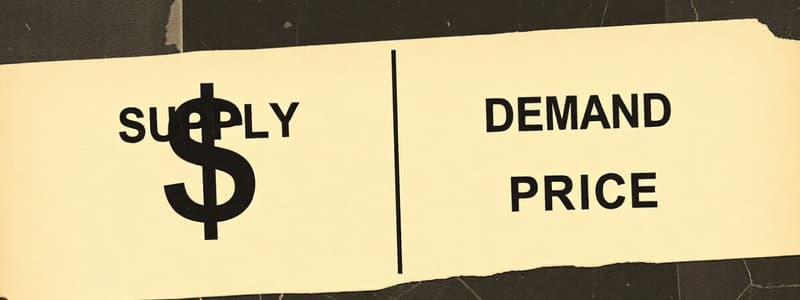Podcast
Questions and Answers
What represents a scenario of excess supply?
What represents a scenario of excess supply?
- Quantity supplied exceeds quantity demanded. (correct)
- Quantity supplied is equal to quantity demanded.
- Quantity demanded exceeds quantity supplied.
- Quantity demanded is unchanged while quantity supplied rises.
What does the equilibrium price indicate?
What does the equilibrium price indicate?
- The price at which suppliers are forced to sell.
- The average price over a long period.
- The maximum price consumers are willing to pay.
- The price at which quantity supplied equals quantity demanded. (correct)
Which factor would likely shift the supply curve to the left?
Which factor would likely shift the supply curve to the left?
- Technological advancements.
- Increase in government subsidies.
- An increase in the number of suppliers.
- Rise in input costs. (correct)
What happens when suppliers expect future prices to rise?
What happens when suppliers expect future prices to rise?
How does a government-imposed price ceiling impact the market?
How does a government-imposed price ceiling impact the market?
Which condition would result in a rightward shift in the supply curve?
Which condition would result in a rightward shift in the supply curve?
What is the inverse supply function used for?
What is the inverse supply function used for?
In what scenario would a supplier reduce the amount of a product they produce without changes in its demand?
In what scenario would a supplier reduce the amount of a product they produce without changes in its demand?
Flashcards
Excess Supply
Excess Supply
When quantity supplied is greater than quantity demanded at a given price.
Equilibrium Price
Equilibrium Price
The price where quantity supplied equals quantity demanded.
Supply Curve
Supply Curve
Graph showing quantity supplied at different prices; horizontal sum of all firms.
Factors Impacting Supply
Factors Impacting Supply
Signup and view all the flashcards
Direct Supply Function
Direct Supply Function
Signup and view all the flashcards
Inverse Supply Function
Inverse Supply Function
Signup and view all the flashcards
Substitutes in Production
Substitutes in Production
Signup and view all the flashcards
Complements in Supply
Complements in Supply
Signup and view all the flashcards
Study Notes
Supply and Equilibrium
- Supply is the quantity of a good sellers are willing to sell at various prices.
- Excess supply occurs when quantity supplied exceeds quantity demanded at the current price.
- Excess demand is the opposite, quantity demanded exceeds quantity supplied.
- Equilibrium price is where quantity supplied equals quantity demanded.
Supply Function
- Direct Supply Function: Q = c - dP (Q = quantity supplied, c = constant, d = constant, P = price)
- Inverse Supply Function: P = (a/b) - (1/b)Q
Equilibrium Price
- Equilibrium Price = (a-c)/(b+d)
Supply Curve
- Shows the quantity supplied at any given price.
- It's the horizontal sum of individual supply curves.
- Quantity supplied is the amount producers are willing to produce at a specific price.
Factors Shifting Supply Curves
- Technology: Improvements shift the curve to the right (lower costs).
- Input costs: Lower input prices shift the curve to the right.
- Government intervention (e.g., subsidies, taxes, price controls): These can shift the curve.
- Supplier expectations: Anticipated price changes can affect supply.
- Number of suppliers: More suppliers shift the curve to the right.
Substitutes in Production
- Different products a supplier can make
- A change in profitability of one product may lead to a change in a related product's supply.
Steps for Analyzing Equilibrium Changes
- Identify curves shifted.
- Determine if shifts are left or right.
- Analyze how the shift affects equilibrium price and quantity.
Demand-Related Effects
- An increase in demand increases both equilibrium price and quantity.
- A decrease in demand decreases both equilibrium price and quantity.
- An increase in supply decreases equilibrium price but increases equilibrium quantity.
- A decrease in supply increases equilibrium price but decreases equilibrium quantity.
Consumer and Producer Surplus
- Consumer Surplus: Difference between what consumers pay and their maximum willingness to pay.
- Producer Surplus: Difference between what producers receive for a good and their minimum willingness to sell it for.
Static Analysis
- Comparative Static Analysis focuses on how changes in economic conditions affect equilibrium price and quantity.
Studying That Suits You
Use AI to generate personalized quizzes and flashcards to suit your learning preferences.



